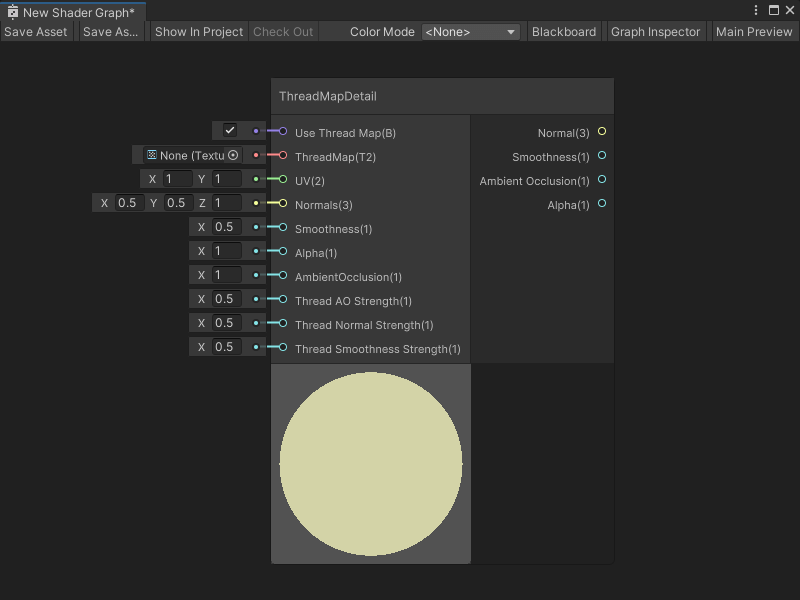# ThreadMapDetail node
The ThreadMapDetail node adds tileable thread map detail information to a fabric material. The node outputs a thread map that you can apply to a fabric material.

[!include[nodes-subgraph-node](./snippets/nodes-subgraph-node.md)]
A thread map is a Texture with 4 channels. Like a detail map, a thread map contains information about ambient occlusion, the normal x-axis and normal y-axis, and smoothness.
For more information on Detail maps, see [Secondary Maps (Detail Maps) & Detail Mask](https://docs.unity3d.com/Manual/StandardShaderMaterialParameterDetail.html) in the Unity User Manual.
## Create Node menu category
The ThreadMapDetail node is under the **Utility** > **High Definition Render Pipeline** > **Fabric** category in the Create Node menu.
## Compatibility
[!include[nodes-compatibility-hdrp](./snippets/nodes-compatibility-hdrp.md)]
[!include[hdrp-latest-link](./snippets/hdrp-latest-link.md)]
[!include[nodes-all-contexts](./snippets/nodes-all-contexts.md)]
## Inputs
[!include[nodes-inputs](./snippets/nodes-inputs.md)]
<table>
<thead>
<tr>
<th><strong>Name</strong></th>
<th><strong>Type</strong></th>
<th><strong>Binding</strong></th>
<th><strong>Description</strong></th>
</tr>
</thead>
<tbody>
<tr>
<td><strong>Use Thread Map</strong></td>
<td>Boolean</td>
<td>None</td>
<td>Use the port's default input to enable or disable the ThreadMapDetail node. You can also connect a node that outputs a Boolean to choose when to enable or disable the thread map.</td>
</tr>
<tr>
<td><strong>ThreadMap</strong></td>
<td>Texture 2D</td>
<td>None</td>
<td>The texture that contains the detailed information of a fabric's thread pattern. The texture should contain 4 channels:
<ul>
<li>R - The ambient occlusion</li>
<li>G - The normal Y-axis</li>
<li>B - The smoothness</li>
<li>A - The normal X-axis</li>
</ul>
</td>
</tr>
<tr>
<td><strong>UV</strong></td>
<td>Vector 2</td>
<td>UV</td>
<td>The UV coordinates the ThreadMapDetail node should use to map the ThreadMap texture on the geometry.</td>
</tr>
<tr>
<td><strong>Normals</strong></td>
<td>Vector 3</td>
<td>None</td>
<td>The base normal map that you want your Shader Graph to apply to the geometry before it applies the thread map.</td>
</tr>
<tr>
<td><strong>Smoothness</strong></td>
<td>Float</td>
<td>None</td>
<td>The base smoothness value that you want your Shader Graph to apply to the geometry before it applies the thread map.</td>
</tr>
<tr>
<td><strong>Alpha</strong></td>
<td>Float</td>
<td>None</td>
<td>The base alpha value that you want your Shader Graph to apply to the geometry before it applies the thread map.</td>
</tr>
<tr>
<td><strong>Ambient Occlusion</strong></td>
<td>Float</td>
<td>None</td>
<td>The base ambient occlusion value that you want your Shader Graph to apply to the geometry before it applies the thread map.</td>
</tr>
<tr>
<td><strong>Thread AO Strength</strong></td>
<td>Float</td>
<td>None</td>
<td>Specify a value of <code>0</code> or <code>1</code> to determine how the <strong>ThreadMap</strong>'s ambient occlusion should impact the final shader result:
<ul>
<li>If you provide a value of <code>0</code>, the <strong>ThreadMap</strong>'s ambient occlusion has no effect on the final output of the shader.</li>
<li>If you provide a value of <code>1</code>, Shader Graph multiplies your base <strong>Ambient Occlusion</strong> value by the ambient occlusion value specified in your <strong>ThreadMap</strong> to determine the final output of the shader.</li></ul></td>
</tr>
<tr>
<td><strong>Thread Normal Strength</strong></td>
<td>Float</td>
<td>None</td>
<td>Specify a value of <code>0</code> or <code>1</code> to determine how the <strong>ThreadMap</strong>'s normal should impact the final shader result:
<ul>
<li>If you provide a value of <code>0</code>, the <strong>ThreadMap</strong>'s normal has no effect on the final output of the shader.</li>
<li>If you provide a value of <code>1</code>, Shader Graph blends the values from your base <strong>Normals</strong> with the normal specified in your <strong>ThreadMap</strong> to determine the final output of the shader.</li></ul></td>
</tr>
<tr>
<td><strong>Thread Smoothness Strength</strong></td>
<td>Float</td>
<td>None</td>
<td>Specify a value of <code>0</code> or <code>1</code> to determine how the <strong>ThreadMap</strong>'s smoothness should impact the final shader result:
<ul>
<li>If you provide a value of <code>0</code>, the <strong>ThreadMap</strong>'s smoothness value has no effect on the final output of the shader.</li>
<li>If you provide a value of <code>1</code>, Shader Graph adds the smoothness value specified in your <strong>ThreadMap</strong> to your base <strong>Smoothness</strong> value to determine the final output of the shader. For this calculation, Shader Graph remaps the value of your <strong>ThreadMap</strong>'s smoothness from (0,1) to (-1, 1).</li></ul></td>
</tr>
</tbody>
</table>
## Outputs
[!include[nodes-outputs](./snippets/nodes-outputs.md)]
<table>
<thead>
<tr>
<th><strong>Name</strong></th>
<th><strong>Type</strong></th>
<th><strong>Description</strong></th>
</tr>
</thead>
<tbody>
<tr>
<td><strong>Normal</strong></td>
<td>Vector 3</td>
<td>The final normal output of the thread map.</td>
</tr>
<tr>
<td><strong>Smoothness</strong></td>
<td>Float</td>
<td>The final smoothness output of the thread map.</td>
</tr>
<tr>
<td><strong>Ambient Occlusion</strong></td>
<td>Float</td>
<td>The final ambient occlusion output of the thread map.</td>
</tr>
<tr>
<td><strong>Alpha</strong></td>
<td>Float</td>
<td>The final alpha output of the thread map. Shader Graph calculates this alpha value by multiplying the input <strong>Alpha</strong> value by the <strong>Thread AO Strength</strong> value.</td>
</tr>
</tbody>
</table>
## Example graph usage
For an example use of the ThreadMapDetail node, see either of the HDRP's Fabric shaders.
To view these Shader Graphs:
1. Create a new material and assign it the **HDRP** > **Fabric** > **Silk** or **HDRP** > **Fabric** > **CottonWool** shader, as described in the Unity User Manual section [Creating a material asset, and assigning a shader to it](https://docs.unity3d.com/Documentation/Manual/materials-introduction.html).
2. Next to the **Shader** dropdown, select **Edit**.
Your chosen Fabric's Shader Graph opens. You can view the ThreadMapDetail node, its Subgraph, and the other nodes that create HDRP's Fabric shaders.